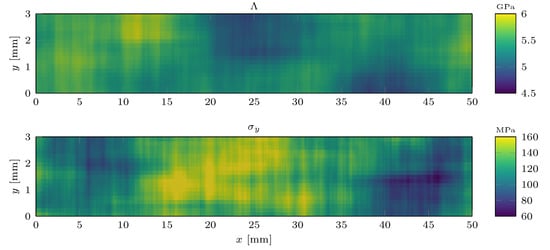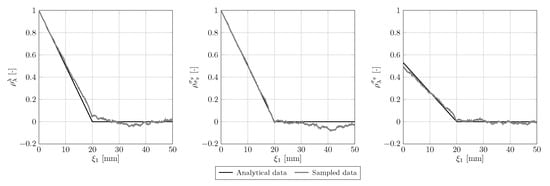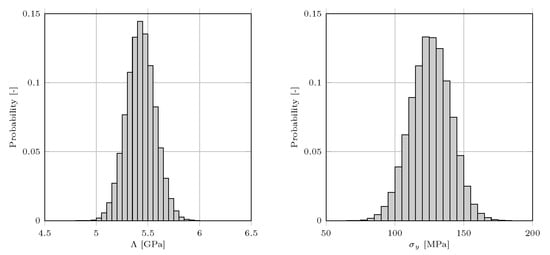Abstract
For the numerical simulation of components made of short fiber-reinforced composites, the correct prediction of the deformation including the elastic and plastic behavior and its spatial distribution is essential. When using purely deterministic modeling approaches, the information of the probabilistic microstructure is not included in the simulation process. One possible approach for the integration of stochastic information is the use of random fields. In this study, numerical simulations of tensile test specimens were conducted utilizing a finite deformation elastic–ideal plastic material model. A selection of the material parameters covering the elastic and plastic domain are represented by cross-correlated second-order Gaussian random fields to incorporate the probabilistic nature of the material parameters. To validate the modeling approach, tensile tests until failure were carried out experimentally, which confirmed the assumption of the spatially distributed material behavior in both the elastic and plastic domain. Since the correlation lengths of the random fields cannot be determined by pure analytic treatments, additionally numerical simulations were performed for different values of the correlation length. The numerical simulations endorsed the influence of the correlation length on the overall behavior. For a correlation length of 5 , a good conformity with the experimental results was obtained. Therefore, it was concluded that the presented modeling approach was suitable to predict the elastic and plastic deformation of a set of tensile test specimens made of short fiber-reinforced composite sufficiently.
1. Introduction
The use of short fiber-reinforced composites (SFRCs) has increased significantly over the years. Due to the specific strength and stiffness in comparison to conventional polymers and the applicability for mold injection production processes, they are of special interest, e.g., in the automotive industry [1]. However, the mold injection process, as well as the finite length of the reinforcing elements result in a microstructure having a probabilistic nature, which significantly affects the mechanical properties [2] and, thus, the structural response. Following this, a probabilistic modeling approach appears to be promising to exploit the lightweight potential in the best possible way.
To reduce the computational costs, the main challenge here is the incorporation of microstructural information without explicit modeling. One stochastic technique to model spatial data is random fields [3,4,5], which are also used in the context of material modeling. Soize and Guilleminot developed a comprehensive framework starting with non-Gaussian positive-definite matrix-valued random fields [6] and tensor-valued random fields for a meso-scale stochastic model of anisotropic elastic microstructures [7]. Based on this paper by Soize, the approach was extended by Guilleminot et al., covering the stochastic fluctuations in fiber-reinforced composites on the mesoscale [8,9], random interphases from atomistic simulations of polymer nanocomposites [10], and a multiscale approach for heterogeneous materials with non-Gaussian random fields [11]. Beside this, random fields are widely used, e.g., for geosystems [12], thin-walled composite cylinders [13], three-dimensional concrete microstructures [14], and the representation of the continuous mode conversion observed by the propagation of guided ultrasonic waves in thin-walled structures made of fiber-reinforced composite [15]. A first application of random fields in the context of nonlinear behavior for isotropic material was provided by Zheng et al. [16]. The application to SFRCs has been limited to the linear elastic domain so far [2]. However, SFRCs show prominent nonlinear behavior, because the matrix material enters the plastic domain even at operation loads [17]. Hence, to predict the structural response correctly even at low stress levels, information about the plastic deformation must be considered. Since the plastic deformation is localized initially, the required nonlinear modeling approach needs to include information about the probabilistic nature of the microstructure causing spatially distributed material properties [18].
Beside the research on random fields for probabilistic material modeling, the modeling of SFRCs at the different scales mostly focuses on homogenization approaches and does not consider the spatial distribution of the material properties on the component level. The determination of a representative volume element (RVE) for random composites was discussed by Savvas et al. [19] by combining the extended finite element method with a Monte Carlo sampling. Breuer et al. [20,21] applied the RVE to SFRCs including artificial neural networks. Zhang et al. investigated the strain rate dependence of SFRCs based on RVEs [22], and Jia et al. applied the RVE concept to cyclic mechanical and thermal loading [23].
Hence, the main objective of this research was the incorporation of the probabilistic material characteristics of SFRCs into a modeling approach covering the elastic and plastic domain on the component level. The presented paper is linked to a correlation structure study of the elastic–ideal plastic material behavior [24], where the moving window method [19,25,26] was utilized for the elastic domain and a homogenization method was used to derive the local apparent plastic material parameters [27,28], respectively. Here, the obtained results are now employed for the numerical simulation of SFRCs on the component level, including an experimental validation. Therefore, first, cross-correlated random fields are generated to describe the spatial distribution and the probabilistic nature of the material properties introduced by the stochastic attributes of the microstructure. In a second step, a transversely isotropic elastic–ideal plastic material model including finite deformation is established and implemented in COMSOL Multiphysics® to simulate tensile tests for specimens made of SFRCs. For validation of the presented modeling approach incorporating the spatial distribution and probabilistic characteristics of elastic and plastic material properties, uniaxial tensile tests are conducted experimentally.
Subsequently, the structure of the present paper is as follows. In Section 2, the experimental investigation is given. This includes a detailed description of the specimens and the experimental setup and procedure, respectively. This is followed by the generation of cross-correlated random fields in Section 3. After the implementation of an algorithm in Multiphysics® covering elasto-plastic material behavior in Section 4, the random fields are used in Section 5 to incorporate spatially distributed material properties into the numerical modeling procedure. Finally, Section 6 gives a summary and conclusion.
2. Experiments
This section gives detailed information about the experimental investigation of the elastic and plastic properties of specimens made of SFRCs by tensile tests. First, the specimen specifications are given before presenting the experimental setup and procedure. The section is concluded with an overview of the experimental results covering the elastic and plastic domain.
2.1. Specimens
In this paper, the elastic and plastic deformation for specimens made of Ultradur B 4300 G6 [29], a polybutylene terephthalate (PBT) matrix material filled with glass fibers, were investigated. The fiber mass fraction was set to , which is equal to a fiber volume fraction of . The specimens were cut out of a larger plate that was manufactured by mold injection. The size of this plate was and had a thickness of 3 . The geometry of the tensile test specimens was defined in accordance with DIN-ISO-527-1 [30]. However, due to the plate dimensions, the size of specimen type 1B was slightly adapted. Figure 1 gives an overview of the initial plate, the position of each specimen, and its exact dimensions.
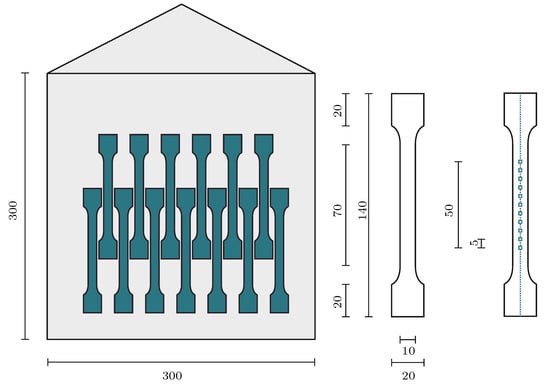
Figure 1.
Details of the specimen geometry and the measurement points. All measures in mm, .
2.2. Experimental Setup and Procedure
For the tensile tests covering the elastic and plastic deformation until failure, a Zwick-Roell Z050 tensile testing machine was used. With this testing machine, a load of up to 50 can be applied. As suggested by DIN-ISO-527-1 for plastics, the tensile test was performed with displacement driven at a speed of 1 /. The strain was captured by a contact-less laser extensometer with an initial measurement length of 50 . Furthermore, to analyze the spatial distribution of the material properties, additional measurement points within the original measurement length were added. They had a distance of 5 ; see Figure 1.
For the elastic characterization of the material, Young’s modulus was derived from the measured stress–strain data. It was determined by computing the slope of the curve between a strain level of and . For the plastic deformation, the strain at failure and the maximum stress level were obtained from the measurement data. This was performed based on the data for a measurement length of 50 for all specimens. In addition, to analyze the spatial distribution qualitatively, the data were obtained for sections of 15 for one specimen. Hence, three non-overlapping different sections of the initial measurement length were examined individually. In all cases, the engineering strain was measured.
2.3. Results
Figure 2 summarizes the results of the conducted tensile tests in the elastic and plastic domain. On the left-hand side, the stress–strain curve for each specimen based on the measurement length 50 is plotted. Furthermore, the diagram holds data provided by the manufacturer [29]. The stress–strain curves clearly revealed the prominent plastic deformation of the SRFC even at low stress levels. However, in comparison with the data sheet, the experimentally obtained stress and strain level at failure were significantly lower. This also held for the slope of the curve in the elastic domain. For a better overview, the corresponding values of Young’s modulus, as well as the stress and strain level at failure are collected in Table 1. For each parameter, the mean value and the standard deviation are provided.
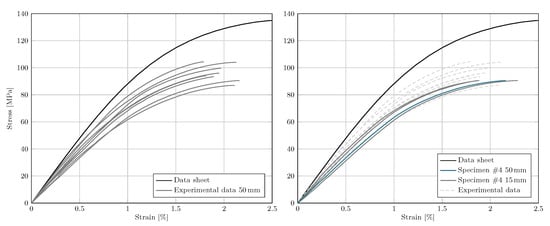
Figure 2.
Experimental results and comparison with the data sheet.

Table 1.
Experimental results obtained by tensile tests in the elastic and plastic domain.
The differences between the experimental data and the data provided by the manufacturer were most likely related to the manufacturing process of the specimen. It significantly influenced the microstructural characteristics such as the fiber length and fiber orientation of the specimen and the quality of the fiber–matrix bonding.
In the second diagram, the focus is set on the spatial distribution of the material properties. For one specimen, the stress–strain curve was not only determined for a measurement length of 50 , but also for three sections of 15 in length each. The sections did not overlap and were within the original measurement length. The different curves revealed that the plastic deformation was distributed over the specimen, confirming the assumption of spatially distributed material properties induced by the finite length of the reinforcing elements and the probabilistic characteristics of the microstructure.
4. Numerical Simulation
In this section, the spatially distributed material properties described by cross-correlated second-order Gaussian random fields are combined with an algorithm for the elastic–ideal plastic material behavior. The main objective was the integration of the locally varying material properties, which were observed during the experimental investigations in Section 2, into a numerical modeling procedure. Therefore, first, the framework and constitutive equations for the transversely isotropic elastic–ideal plastic material behavior and its implementation in COMSOL Multiphysics® are presented. The developed algorithm was then validated in detail.
4.1. Framework of Elastic-Ideal Plastic Material Behavior
4.1.1. Constitutive Equations
The constitutive model of the elastic–ideal plastic material behavior comprises the following equations:
- Elastic constitutive equation;
- Flow rule;
- Yield condition.
which need to satisfy the Kuhn–Tucker complementary conditions and the consistency condition [54]. The plastic constitutive material model introduced here was based on the research provided by Hashiguchi et al. [55] and Eidel et al. [56]. It was adapted to the transversely isotropic material by using the strain–energy density function by Bonet et al. [57]. Furthermore, hardening was not considered. Hence, the material was assumed to show the ideal plastic behavior [24].
Since the modeling approach covers finite deformation, the constitutive model needs to be formulated with respect to the nonlinear continuum mechanical framework. Therefore, the deformation is described by the multiplicative decomposition of the deformation gradient, also known as Kröner–Lee decomposition. The decomposition is given by [58,59,60,61]
Here, holds the elastic and the plastic deformation, respectively. Since the deformation gradient was used to map continuum mechanical quantities from the reference to the current configuration and vice versa, this decomposition revealed the definition of an additional configuration, the so-called intermediate configuration [54,58,60]. As shown in Figure 6, with , the quantities were mapped from the reference to the intermediate configuration and with from the intermediate to the current configuration. Accordingly,
holds, with being the right Cauchy–Green tensor, defined in the reference configuration. It also splits into an elastic and a plastic part written by the decomposition [62]:
where
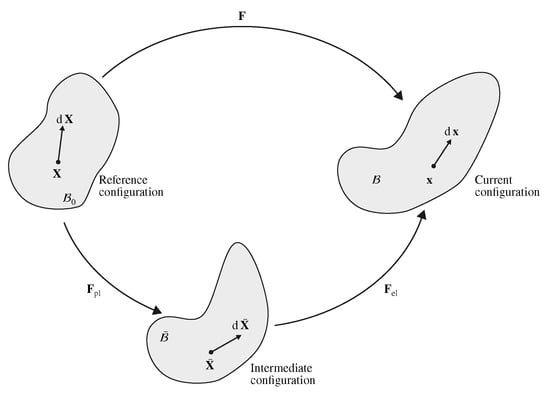
Figure 6.
Configuration definition within the nonlinear continuum mechanics framework.
Assuming -plasticity and, hence, plastic incompressibility leads to
and
respectively. With respect to the introduced configurations, , which is located in the intermediate configuration, contains the elastic deformation, whereas was assigned to the reference configuration and includes the plastic deformation.
A crucial part of the plasticity framework is the plastic flow rule providing information about the irreversible deformation of a body. The fundamental equation is the second law of thermodynamics provided by the Clausian–Duhem inequality for isothermal processes, which is written as [63]
where the dot indicates the derivative with respect to time, is the second Piola–Kirchhoff stress tensor, and the Helmholtz free energy. Introducing the Helmholtz free energy as a function of , the associated rate can be expressed by
Since, in this case, both kinematic and isotropic hardening were omitted, only the part of the Helmholtz free energy , which was assigned to the elastic deformation, contributes to Equation (26). Following the multiplicative decomposition of , the derivative of the right Cauchy–Green tensor with respect to time is obtained by [56]
with the plastic velocity gradient in the intermediate configuration
Combining the inequality in Equation (26) and the time derivative of , which must hold for arbitrary thermodynamic processes, one can derive, first, the constitutive equation for elastic deformation, which defines the second Piola–Kirchhoff stress tensor in the intermediate configuration:
and, second, the reduced form of the Clausian–Duhem inequality [56,63]:
again omitting isotropic and kinematic hardening. In this formulation, the Mandel stress tensor is introduced. It is defined as
and stands in the intermediate configuration.
The inequality in Equation (26) is satisfied by the associated flow rule [56,63]:
assuming an isotropic yield function [56]. In this research, the framework of -plasticity was used. Therefore, the yield function is introduced as a von Mises criterion by [55]
where is the reference yield stress for uniaxial loading and, hence, an independent material parameter and denotes the norm of the deviatoric part of the Mandel stress. Substituting the von Mises yield function in Equation (34) into Equation (33) leads to [55,63]
With this framework at hand, the flow rule is written as [56]
To solve this equation, an implicit backward Euler-type tensor exponential-based time integration scheme was used. Following this procedure, the updated plastic part of the deformation gradient is obtained by [56,64]
with the exponential function:
The subscripts n and denote the corresponding steps, where n indicates the initial and the updated values.
The presented framework of elastic–ideal plastic deformation was applied to the transversely isotropic material behavior characterizing SFRCs in the next step. Therefore, the constitutive equations were used within the context of the finite element method. The resulting routine can be divided into four steps, which are presented in detail below.
4.1.2. Solution Procedure
Elastic Predictor
In the initial step, the deformation of the body was assumed to be purely elastic, which is described in the intermediate configuration, as shown before. Following the research of Simo et al., who derived the framework of the finite strain elasto-plasticity by combining the multiplicative decomposition of the deformation gradient with hyperelastic strain–energy density functions [65,66,67], the elastic deformation is obtained by evaluating the hyperelastic strain–energy density function with respect to the elastic part of the deformation.
In this study, the elastic material behavior of the SFRC is described by the potential [57]
Here, , , , , and are the independent material parameters characterizing the transversely isotropic material behavior. In addition to the well-known invariants , and for the description of the isotropic material behavior [68,69], the quantities and give the pseudo-invariants, which are defined for a symmetric second-order tensor by [70,71]
The vector gives the fiber orientation and, therefore, holds the transversely isotropic characteristics of the material. In this case, it was assumed that the fibers are mainly orientated along the tensile test specimen. Hence, and hold.
With respect to the used transversely isotropic potential and the tensor derivatives, given by
the second Piola–Kirchhoff stress tensor in the intermediate configuration reads
Checking Yield Condition
To be able to evaluate the yield condition, provided in Equation (34), in the intermediate configuration, the deviatoric part of the Mandel stress must be computed to derive the corresponding von Mises stress.
If the resulting von Mises stress is lower than the yield strength of the material, the body shows only elastic deformation. Therefore, no further action is required. The stress measure can be updated with the trial value obtained by the elastic predictor step. If, however, the von Mises stress is larger than the yield strength, the body shows not only elastic, but also plastic deformation. In this case, the determination of the resulting plastic deformation is covered by the plastic corrector step.
Plastic Corrector Step (Return Mapping)
Since the yield condition is given in the intermediate configuration, this also holds for the computation of the updated plastic part of the deformation gradient.
As shown before, an associative plastic flow rule introduced by Eidel et al. [56] was used to describe the evaluation of the plastic deformation. With this framework at hand, the return mapping procedure in the case of plastic deformation leads to the following system of equations (cf. Equation (37)):
which needs to be solved to obtain the updated quantities at the step for the plastic deformation. Since the plastic part of the deformation gradient depends solely on the plastic multiplier (see Equations (37) and (38)), a Newton-scheme algorithm was used to determine the updated components of the plastic deformation gradient. Therefore, the yield criterion was iteratively solved with respect to , and the procedure was stopped when a maximum number of iterations or a converged solution was reached by satisfying the condition:
Furthermore, the required derivative was calculated numerically by deploying a one-sided difference scheme:
Updating
With the obtained value of satisfying the yield condition, the updated plastic deformation gradient can be calculated by evaluating Equations (37) and (38). Next, the resulting second Piola–Kirchhoff stress tensor in the intermediate configuration was derived. Therefore, the updated elastic part of the deformation gradient was computed and introduced in Equation (42). COMSOL Multiphysics® requires the computation of the second Piola–Kirchhoff stress tensor and the consistent tangent modulus tensor with respect to the reference configuration. Hence, a pull-back operation:
was applied to obtain the second Piola–Kirchhoff stress tensor in the reference configuration. The last step was the computation of the consistent tangent modulus tensor. The corresponding procedure is provided in detail in the next section.
4.1.3. Variational Formulation and Consistent Tangent Modulus Tensor
For a body , the local form of the balance of momentum with respect to the reference configuration reads
Here, is the first Piola–Kirchhoff stress tensor, is the density, are the volume forces, and is the displacement field. To solve this differential equation, Neumann and Dirichlet boundary conditions were used. They are given by
where is the boundary surface of and gives the normal to the boundary surface . To ensure that the boundary conditions cover the complete surface of the body, and hold. Applying standard variational calculus on Equation (47) and leads to
for the equilibrium state of the body . Based on the definition:
the virtual right Cauchy–Green deformation tensor, expressed with respect to the virtual deformation gradient , is given by
To solve this nonlinear equation within the FEM framework, a standard Newton-Raphson iteration scheme was used. To ensure a quadratic convergence rate, a consistent linearization of the principal of virtual displacement in Equation (50) is crucial. Therefore, in this paper, the perturbation technique developed by Miehe [72] was used. This approach is widely used and has been extensively investigated with respect to convergence properties and the application within the finite strain framework [56,73,74]. Due to the symmetry of , the linear increment of F can be formulated as
where is the linearized virtual right Cauchy–Green deformation tensor given in terms of the incremental deformation gradient . To obtain the incremental second Piola–Kirchhoff stress tensor , the consistent tangent modulus tensor is required. In the reference configuration, it is expressed by
which can be written as
The incremental change of the right Cauchy–Green tensor was obtained by applying a perturbation technique to the deformation gradient. Following this, the incremental change of the right Cauchy–Green tensor is given by
with
Subsequently, the perturbed deformation gradient reads
With this, the corresponding perturbed incremental right Cauchy–Green tensor can be calculated, which enables one to compute the stresses by applying the presented return mapping algorithm. This leads to the stress increment:
and, hence, the consistent tangent modulus tensor by evaluating Equation (55)
4.2. Implementation in COMSOL Multiphysics®
4.2.1. Algorithm
Using an external material option in COMSOL Multiphysics® requires the generation of a C-based dll, which can be loaded via the COMSOL Multiphysics® interface. With respect to the presented elastic–ideal plastic material model introduced in Section 4.1, the general stress deformation routine was used. The input and output parameter for a general stress deformation subroutine for the implementation in COMSOL Multiphysics® are provided in Table 3. In addition to these variables, optional ones can be stored utilizing state variables. Table 4 gives an overview of the state variables used in the presented algorithm for the elastic–ideal plastic material behavior of SFRCs.

Table 3.
List of input and output variables for a general stress deformation routine in COMSOL Multiphysics®.

Table 4.
List of state variables used in the algorithm for the elastic–ideal plastic material behavior in COMSOL Multiphysics®.
With these definitions and the framework provided in Section 4.1, an algorithm was established to compute the second Piola–Kirchhoff stress tensor and the Jacobian matrix of the second Piola–Kirchhoff stress tensor with respect to deformation gradient. The structure of the developed routine is depicted in Figure 7. The main routine eval reads the input variables, calls the subroutine retmap, which is responsible for the return mapping procedure, and updates all output and state variables. A detailed overview of the routine is provided by Algorithm 1. In addition, Algorithm 2 and Table 5 hold all the information about the subroutine retmap. The details of all remaining supporting routines indicated in Figure 7 are given in Appendix A.
| Algorithm 1 Main routine implemented in COMSOL Multiphysics® for the calculation of and . |
|
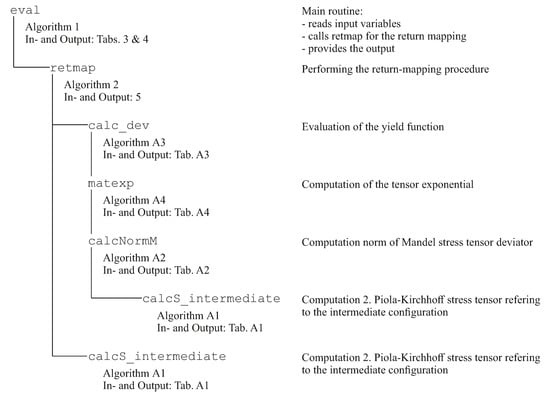
Figure 7.
Structure of the implemented algorithm.

Table 5.
List of input and output variables for the subroutine retmap in COMSOL Multiphysics®.
| Algorithm 2 Return mapping algorithm implemented in COMSOL Multiphysics® for the calculation of and . |
Input: see Table 5 Output: see Table 5
|
4.2.2. Validation of the Algorithm
For the validation process, a two-dimensional numerical model under the plane strain assumption representing the cross-section of a tensile test specimen was used. The size of the numerical model was 50 × 3 . In Figure 8, the numerical model and the corresponding boundary conditions are depicted. To reduce convergence issues during the plastic deformation, the simulation was displacement driven. Besides that, the numerical model was discretized by four-node elements with a size of . Hence, over the thickness, the cross-section was discretized with 12 and along the cross-section with 200 elements.

Figure 8.
Two-dimensional numerical model.
Due to the fact that COMSOL Multiphysics® experiences some issues when combining a user-defined hyperelastic strain–energy density function with plasticity, the provided algorithm was validated in two steps. In the first step, the external material algorithm was validated based on the well-known hyperelastic neo-Hookean material model [75]. Therefore, the strain–energy density function within the presented algorithm was adapted to the one implemented in COMSOL Multiphysics® for the neo-Hookean material model given by
Subsequently, two numerical simulations were performed, one with the implemented neo-Hookean hyperelastic material model and the second one with the provided external material algorithm. In both cases, the ideal plasticity and a plain-strain state were assumed. The corresponding material properties are provided in Table 6. Furthermore, a total displacement of corresponding to a strain of was applied to ensure plastic deformation. In a second step, the strain–energy density function provided by Bonet et al. [57] was passed to COMSOL Multiphysics® as a user-defined potential. Since this cannot be combined with the ideal plastic behavior due to convergence issues, this was only simulated assuming elastic deformation. The results were compared again to the results provided by Algorithm 1. The corresponding material parameters are also provided in Table 6.

Table 6.
Material parameters validation with neo-Hookean material model.
The results are depicted in Figure 9. The first row gives the result for the isotropic neo-Hookean simulation, and the second row holds the results for the transversely isotropic simulations. The diagrams on the left-hand side contain the stress–strain curves. The von Mises stress is plotted in black, and the horizontal component of the second Piola–Kirchhoff stress is plotted in gray, respectively. Following the theoretical framework provided in Section 4.1, it is important to note that the von Mises stress is given in the intermediate configuration, whereas the second Piola–Kirchhoff stress tensor stands in the reference configuration. The solid lines give the results of the implemented material model in COMSOL Multiphysics®, and the small circles belong to the results obtained by the external material routine. As indicated by the diagrams on the right-hand side, which provide the deviation of the external material routine to the implemented material model in percent, both validation steps showed good agreement. Both comparisons experienced an increasing deviation at large displacements, which was still very small.
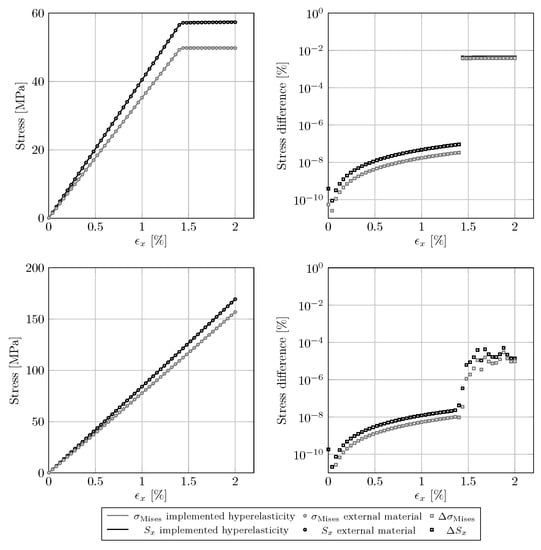
Figure 9.
Numerical validation of the implemented general stress–deformation algorithm in COMSOL Multiphysics®.
5. Application to Tensile Test Specimen
In this last step, the presented modeling approach was used to incorporate the spatially distributed elastic–ideal plastic material behavior of the SFRC into a numerical simulation of tensile tests. As mentioned before, the probabilistic characteristics of the material parameters were analyzed in a former study of the authors [24]. The main results are summarized in Table 2 for a window size of 750 , which showed the best approximation for the simulation on the component level [76]. In this section, the numerical model is briefly introduced, the numerical results are shown and the corresponding results discussed in detail, including a comparison with the experimental data presented in Section 2. This includes the analysis of the influence of the correlation length on the standard deviation of the obtained results and the selection of an optimal correlation length for which the numerical results and the experimental measurements coincided the best.
5.1. Numerical Model
The numerical model used to validate the novel modeling approach on the component level based on tensile test specimens was identical to the one used in Section 4.2.2. As already discussed in Section 3.2, only one parameter of the strain–energy density function and the yield strength were represented by the cross-correlated second-order Gaussian random fields. This reduced the complexity at this state of the investigation. Since, in this case, the standard deviation of the material parameter did not cover the total standard deviation of elasticity tensor element , which is significantly related to the structural behavior under uniaxial tension, the corresponding value was set to . Furthermore, the experimental data clearly revealed that local plastic deformation occurred even at low stress levels. This was related to the yield strength of the matrix material and to the plastic deformation induced by the stress peaks at the edges of the reinforcing elements. In addition, the maximal stress level of the data sheet and, hence, the results of the homogenization were not reached. Therefore, the mean value and the standard deviation were adjusted and set to 100 and 31 , respectively. The remaining parameters were assumed to be homogeneous and were set to the mean values obtained by a previous correlation analysis [24]. Furthermore, a plain strain state was employed. This was eligible because the microstructure of the SFRC consisted of layers with different main fiber orientations [77,78]. The core layer, which was located in the center of the cross-section, was characterized by a fiber orientation perpendicular to the main flow direction of the injection mold process. With respect to the specimens used in this study, the fibers within the small core layer were perpendicular to the load direction and, hence, inhibited the out-of-plane deformation.
Further crucial parameters for the numerical simulation were the correlation lengths of the random fields. Since the correlation length significantly influences the local distribution of the material properties, it was strongly linked to the standard deviation of the numerical results. Therefore, in this study, different values were used to analyze the influence more in detail. In Figure 10, realizations for the strain–energy density function parameter are depicted for a correlation length in the horizontal direction of , , and . In the vertical direction, the correlation length was set to . The effect of the correlation length on the random field is clearly observable. In analogy to the description of the oscillations, the correlation length can be interpreted as the wavelength of the dominant eigenfunctions.

Figure 10.
Discretizations of cross-correlated homogeneous second-order Gaussian random fields to represent the spatially distributed material parameter for different values of .
In this paper, the numerical simulations were performed for horizontal correlation lengths of , , and . The correlation length in the vertical direction was set to for all simulations. This value was chosen to allow plastic deformation at different locations, as was observed during the experimental investigations. In combination with the ideal plastic modeling approach, the resulting stress–strain relation approximated the experimental data for the reinforced material. Were the correlation length be identical to the specimen’s thickness of 3 , the plastic deformation was limited to the region where the yield strength was reached first, because the surrounding material cannot take higher stress levels. The obtained results would then be characterized purely by the ideal plastic behavior of the matrix material.
The numerical simulations were carried out for eight different realizations per correlation length. Hence, in total, 24 simulations were conducted. The results are presented below.
5.2. Results
The results of the numerical simulations are summarized in Figure 11. Furthermore, a comparison of the numerical data with the experimental results is included. The diagrams on the left-hand side contain the stress–strain curve (black), taken from the data sheet [29], the experimental data (gray) (see Section 2), and the numerically obtained results (colored) for correlation lengths of , , and from top to bottom. The diagrams on the right hold again the stress–strain curve (black), taken from the data sheet [29] and the numerical data (gray). One dataset is highlighted. The corresponding stress–strain curve was based on a measurement length of 50 . For these specimens, the spatial distribution of the material properties was qualitatively investigated by deriving the results for three sections of 15 each.
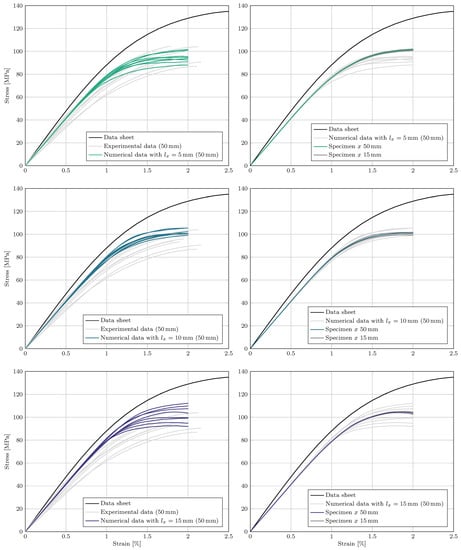
Figure 11.
Results of the numerical simulation in comparison with the experimentally obtained results and a stress–strain curve provided by the manufacturer [29].
For a better comparability, Table 7 holds some additional information. For strain levels of %, %, %, %, and %, the mean stress, as well as the standard deviations were computed for the numerical and experimental data. For all numerical results, the stress refers to the horizontal component of the second Piola–Kirchhoff stress tensor.

Table 7.
Deviation of the second Piola–Kirchhoff stress tensor component for the examined correlation lengths at different strain levels and comparison with the experimental data.
5.3. Discussion
The diagrams provided in Figure 11 reveal that the numerical obtained stress–strain curves clearly showed the expected elasto-plastic behavior. Despite the fact that the material behavior was modeled based on the assumption of an elastic–ideal plastic material model, the resulting stress–strain curves showed an overall good agreement with the experimental data. This was related to the localized plastic deformation and the rearrangement of the applied loading. In addition, the diagrams disclose, which the numerical results showed, a better agreement with the experimental data for a decreasing correlation length. This is also indicated by the values provided in Table 7. For a decreasing correlation length, the mean stress state converged to the experimentally obtained values; for a correlation length of 5 , the results showed an overall good agreement. The deviation between the mean stress states at the different strain levels for the experimental and numerical results was covered by the standard deviation. However, despite the good overall conformity, the results indicated two shortcomings. First, the experimentally obtained stress range at strain levels up to 1% was not covered by the numerical simulation. This might be due to the reduction of the parameters, which were represented by random fields. Second, even though the composite material did not show explicitly ideal plasticity, the plastic deformation within the numerical simulations started at higher strain levels, as indicated by the experimental results. This might be resolved by reducing the yield strength locally or taking into account hardening effects.
The modeling approach was further endorsed by the results on the right-hand side by two important aspects. First, the modeling approach led to a plastic deformation covering the whole specimen and, hence, did not show localized plastic deformation. Second, when dividing the measurement length into small sections, each section showed a slightly different behavior. Both phenomena were confirmed by the experimental investigation.
All in all, it can be stated that the presented modeling approach is a very appropriate method to incorporate the spatial distribution of the elastic and plastic material properties of SFRCs.
6. Summary and Conclusions
In this manuscript, a probabilistic modeling approach for the elasto-plastic material behavior at finite strain based on second-order Gaussian random fields was introduced. The description of the material behavior was based on the Kröner–Lee decomposition. Following this, the strain–energy density function introduced by Bonet et al. [57] was combined with a classical -plasticity formulation assuming ideal plastic behavior. Since this material model was not available in commercially available finite element codes, first, an algorithm covering the transversely isotropic elastic–ideal plastic material behavior was developed and implemented in COMSOL Multiphysics®. The validation based on the well-known neo-Hookean material model in the elastic and plastic domain, as well as utilizing a user-defined strain–energy density function in the elastic domain showed an excellent conformity.
Therefore, in the second step, based on the correlation analysis performed in a previous study [24], cross-correlated second-order Gaussian random fields were generated to represent the spatial distribution, the strain–energy density function parameter , and the yield strength induced by the probabilistic characteristics of the microstructure. The remaining parameters were assumed to be homogeneous at this state of the study. With the spatially distributed material properties, tensile tests for specimens made of PBT-GF-30 were simulated. Even though the initial modeling approach was based on the elastic–ideal plastic material behavior, the spatial distribution of the two material parameters led to localized plastic deformation covering the whole measurement length. This caused a strain-dependent reduction of the material stiffness.
To validate the numerical results and the presented modeling approach, uniaxial tensile tests were conducted to characterize the elastic and plastic deformation of PBT-GF-30. The obtained stress–strain curves were compared to the numerical results. It was shown that, with an decreasing correlation length, the numerical data matched the experimental results quite well. The deviation at large strain can be assigned to the assumption of ideal plasticity. Furthermore, this initial investigation did not show a significant deviation between the results of different realizations at a low strain level. The reasons were the reduction of the complexity by representing only one parameter of the strain–energy density function by a random field and the limitation of Gaussian random fields. To ensure only positive values for the yield strength, low values were underestimated.
Summarizing, it can be concluded that the presented initial probabilistic approach is suitable for the numerical simulation of the elasto-plastic material behavior of SFRCs at finite strain including the spatial distribution on the component level without the need for an explicit microstructural modeling. However, the approach is not limited to SFRCs. It can be used to represent any material system with a probabilistic microstructure, which is the key advantage of the presented approach.
Future research will focus on the implementation of specimen unloading, hardening, non-Gaussian random fields, and the representation of additional parameters by stochastic methods.
Funding
The financial support of the German Academic Exchange Service (Grant No. 91789376) is gratefully acknowledged.
Institutional Review Board Statement
Not applicable.
Informed Consent Statement
Not applicable.
Data Availability Statement
The data presented in this study are available upon request from the corresponding author.
Acknowledgments
I want to acknowledge and extend my sincere thanks to Celia Reina for the valuable ideas and tips during our discussions, which significantly improved and shaped the research.
Conflicts of Interest
The author declares no conflict of interest. The funders had no role in the design of the study; in the collection, analyses, or interpretation of the data; in the writing of the manuscript; nor in the decision to publish the results.
Abbreviations
The following abbreviations are used in this manuscript:
| DIN | German Institute for Standardization |
| EOLE | Expansion optimal linear estimate |
| FEM | Finite element method |
| ISO | International Organization for Standardization |
| KLE | Karhunen–Loève expansion |
| mcKL | Multiple correlated Karhunen–Loève expansion |
| muKL | Multiple uncorrelated Karhunen–Loève expansion |
| PBT | Polybutylene terephthalate |
| RVE | Representative volume element |
| SFRC | Short fiber-reinforced composite |
| std | Standard deviation |
Appendix A
For the implementation of the elastic–ideal plastic routine in COMSOL Multiphysics®, several subroutines were used to calculate the second Piola–Kirchhoff stress tensor in the intermediate and reference configuration, respectively. Furthermore, the subroutine to calculate the exponential functions matexp provided by Hashiguchi et al. [55] written in Fortran was transferred into C. Besides these subroutines, COMSOL Multiphysics® provides a library of utility functions for various tensor operations, computing principle and equivalent stresses. These routines are not explained here; a detailed overview is given in the documentation [79].

Table A1.
List of input and output arguments for Algorithm A1 (CalcS_intermediate).
Table A1.
List of input and output arguments for Algorithm A1 (CalcS_intermediate).
| Variable | Symbol | Description |
|---|---|---|
| Cel | Input: elastic part of the right Cauchy–Green tensor | |
| lam | Input: material parameter | |
| mu | Input: material parameter | |
| alpha | Input: material parameter | |
| beta | Input: material parameter | |
| gamma | Input: material parameter | |
| tol_inv | − | Input: tolerance for numerical matrix inversion |
| S | Output: second Piola–Kirchhoff stress tensor with respect to the intermediate configuration |

Table A2.
List of input and output arguments for Algorithm A2 (calcNormM).
Table A2.
List of input and output arguments for Algorithm A2 (calcNormM).
| Variable | Symbol | Description |
|---|---|---|
| F | Input: Deformation gradient | |
| Fpl | Input: plastic part of the deformation gradient | |
| Mdev | Input: deviatoric part of Mandel stress with respect to the intermediate configuration | |
| lam | Input: material parameter | |
| mu | Input: material parameter | |
| alpha | Input: material parameter | |
| beta | Input: material parameter | |
| gamma | Input: material parameter | |
| tol_inv | − | Input: tolerance for numerical matrix inversion |
| dnormx | Output: norm of deviatoric part of Mandel stress with respect to the intermediate configuration |

Table A3.
List of input and output arguments for Algorithm A3 (calc_dev).
Table A3.
List of input and output arguments for Algorithm A3 (calc_dev).
| Variable | Symbol | Description |
|---|---|---|
| dp | Input: plastic multiplier | |
| F | Input: deformation gradient | |
| Fpl | Input: plastic part of the deformation gradient | |
| lam | Input: material parameter | |
| mu | Input: material parameter | |
| alpha | Input: material parameter | |
| beta | Input: material parameter | |
| gamma | Input: material parameter | |
| sigYs | Input: yield stress | |
| dev | Output: value of the yield function |

Table A4.
List of input and output arguments for Algorithm A4 (matexp).
Table A4.
List of input and output arguments for Algorithm A4 (matexp).
| Variable | Symbol | Description |
|---|---|---|
| nmax | − | Input: maximum number of terms of the series representation |
| etol | − | Input: convergence tolerance |
| a | − | Input: matrix |
| aexp | − | Output: tensor exponential function |
| Algorithm A1 Subroutine implemented in COMSOL Multiphysics® for the calculation of . |
| Algorithm A2 Subroutine implemented in COMSOL Multiphysics® for the calculation of |
| Algorithm A3 Subroutine implemented in COMSOL Multiphysics® for the evaluation of . |
| Algorithm A4 Subroutine implemented in COMSOL Multiphysics® for the calculation of the tensor exponential function, adapted from Hashiguchi et al. [55]. |
|
References
- Ebrahimi, F.; Dabbagh, A. A comprehensive review on modeling of nanocomposite materials and structures. J. Comput. Appl. Mech. 2019, 50, 197–209. [Google Scholar]
- Rauter, N. A computational modeling approach based on random fields for short fiber-reinforced composites with experimental verification by nanoindentation and tensile tests. Comput. Mech. 2021, 67, 699–722. [Google Scholar] [CrossRef]
- Hristopulos, D.T. Random Fields for Spatial Data Modeling: A Primer for Scientists and Engineers; Advances in Geographic Information Science; Springer: Dordrecht, The Netherlands, 2020. [Google Scholar]
- Maccone, C. Deep Space Flight and Communications: Exploiting the Sun as a Gravitational Lens; Springer Praxis Books; Springer: Berlin/Heidelberg, Germany, 2009. [Google Scholar]
- Vanmarcke, E. Random Fields: Analysis and Synthesis, Rev. and Expanded New Ed. ed.; World Scientific Publ: Singapore, 2010. [Google Scholar]
- Soize, C. Non-Gaussian positive-definite matrix-valued random fields for elliptic stochastic partial differential operators. Comput. Methods Appl. Mech. Eng. 2006, 195, 26–64. [Google Scholar] [CrossRef]
- Soize, C. Tensor-valued random fields for meso-scale stochastic model of anisotropic elastic microstructure and probabilistic analysis of representative volume element size. Probabilistic Eng. Mech. 2008, 23, 307–323. [Google Scholar] [CrossRef]
- Guilleminot, J.; Soize, C.; Kondo, D.; Binetruy, C. Theoretical framework and experimental procedure for modelling mesoscopic volume fraction stochastic fluctuations in fiber reinforced composites. Int. J. Solids Struct. 2008, 45, 5567–5583. [Google Scholar] [CrossRef][Green Version]
- Guilleminot, J.; Soize, C.; Kondo, D. Mesoscale probabilistic models for the elasticity tensor of fiber reinforced composites: Experimental identification and numerical aspects. Mech. Mater. 2009, 41, 1309–1322. [Google Scholar] [CrossRef]
- Le, T.T.; Guilleminot, J.; Soize, C. Stochastic continuum modeling of random interphases from atomistic simulations. Application to a polymer nanocomposite. Comput. Methods Appl. Mech. Eng. 2016, 303, 430–449. [Google Scholar] [CrossRef]
- Guilleminot, J.; Soize, C. Non-Gaussian Random Fields in Multiscale Mechanics of Heterogeneous Materials. In Encyclopedia of Continuum Mechanics; Altenbach, H., Öchsner, A., Eds.; Springer: Berlin/Heidelberg, Germany, 2017; pp. 1–9. [Google Scholar] [CrossRef]
- Chen, G.; Suo, X. Constitutive modeling of nonlinear compressive behavior of fiber reinforced polymer composites. Polym. Compos. 2020, 41, 182–190. [Google Scholar] [CrossRef]
- de Groof, V.; Oberguggenberger, M.; Haller, H.; Degenhardt, R.; Kling, A. A case study of random field models applied to thin-walled composite cylinders in finite element analysis. In Proceedings of the 11th International Conference on Structural Safety & Reliability, New York, NY, USA, 16–20 June 2013. [Google Scholar]
- Stefanou, G.; Savvas, D.; Metsis, P. Random Material Property Fields of 3D Concrete Microstructures Based on CT Image Reconstruction. Materials 2021, 14, 1423. [Google Scholar] [CrossRef]
- Zimmermann, E.; Eremin, A.; Lammering, R. Analysis of the continuous mode conversion of Lamb waves in fiber composites by a stochastic material model and laser vibrometer experiments. GAMM-Mitteilungen 2018, 41, e201800001. [Google Scholar] [CrossRef]
- Zheng, K.; Yang, K.; Shi, J.; Yuan, J.; Zhou, G. Innovative methods for random field establishment and statistical parameter inversion exemplified with 6082-T6 aluminum alloy. Sci. Rep. 2019, 9, 17788. [Google Scholar] [CrossRef] [PubMed]
- Huang, H.B.; Huang, Z.M. Micromechanical prediction of elastic-plastic behavior of a short fiber or particle reinforced composite. Compos. Part Appl. Sci. Manuf. 2020, 134, 105889. [Google Scholar] [CrossRef]
- Rauter, N.; Lammering, R. Experimental Characterization of Short Fiber-Reinforced Composites on the Mesoscale by Indentation Tests. Appl. Compos. Mater. 2021, 28, 1747–1765. [Google Scholar] [CrossRef]
- Savvas, D.; Stefanou, G.; Papadrakakis, M. Determination of RVE size for random composites with local volume fraction variation. Comput. Methods Appl. Mech. Eng. 2016, 305, 340–358. [Google Scholar] [CrossRef]
- Breuer, K.; Stommel, M. RVE modelling of short fiber reinforced thermoplastics with discrete fiber orientation and fiber length distribution. SN Appl. Sci. 2020, 2, 140. [Google Scholar] [CrossRef]
- Breuer, K.; Stommel, M. Prediction of Short Fiber Composite Properties by an Artificial Neural Network Trained on an RVE Database. Fibers 2021, 9, 8. [Google Scholar] [CrossRef]
- Zhang, S.; van Dommelen, J.A.W.; Govaert, L.E. Micromechanical Modeling of Anisotropy and Strain Rate Dependence of Short-Fiber-Reinforced Thermoplastics. Fibers 2021, 9, 44. [Google Scholar] [CrossRef]
- Jia, D.; Shi, H.; Cheng, L. Multiscale thermomechanical modeling of short fiber-reinforced composites. Sci. Eng. Compos. Mater. 2017, 24, 765–772. [Google Scholar] [CrossRef]
- Rauter, N. Correlation analysis of the elastic–ideal plastic material behavior of short fiber-reinforced composites. Int. J. Numer. Methods Eng. 2022, 2022, 1–19. [Google Scholar] [CrossRef]
- Baxter, S.C.; Graham, L.L. Characterization of Random Composites Using Moving-Window Technique. J. Eng. Mech. 2000, 126, 389–397. [Google Scholar] [CrossRef]
- Graham-Brady, L.L.; Siragy, E.F.; Baxter, S.C. Analysis of Heterogeneous Composites Based on Moving-Window Techniques. J. Eng. Mech. 2003, 129, 1054–1064. [Google Scholar] [CrossRef]
- Ponte Castañeda, P. The effective mechanical properties of nonlinear isotropic composites. J. Mech. Phys. Solids 1991, 39, 45–71. [Google Scholar] [CrossRef]
- Ponte Castañeda, P. Stationary variational estimates for the effective response and field fluctuations in nonlinear composites. J. Mech. Phys. Solids 2016, 96, 660–682. [Google Scholar] [CrossRef]
- Chemie Wirtschaftsförderungsgesellschaft mbH. CAMPUS® Datasheet: Ultradur® B 4300 G6-PBT-GF30. 2021. Available online: https://www.campusplastics.com/material/pdf/140403/UltradurB4300G6?sLg=en (accessed on 25 June 2021).
- International Organization for Standardization. Plastics–Determination of Tensile Properties: Part 1: General Principles, ISO 527-1:2019 ed.; International Organization for Standardization: Geneva, Switzerland, 2019. [Google Scholar]
- Ghanem, R.G. Stochastic Finite Elements: A Spectral Approach; Springer: New York, NY, USA, 2012. [Google Scholar]
- Sudret, B.; Der Kiurghian, A. Stochastic Finite Element Methods and Reliability: A State-of-the-Art Report; Report No. ucb/semm-2000/08; University of California: Berkeley, CA, USA, 2000. [Google Scholar]
- Chu, S.; Guilleminot, J. Stochastic multiscale modeling with random fields of material properties defined on nonconvex domains. Mech. Res. Commun. 2019, 97, 39–45. [Google Scholar] [CrossRef]
- Guilleminot, J. 12-Modeling non-Gaussian random fields of material properties in multiscale mechanics of materials. In Uncertainty Quantification in Multiscale Materials Modeling; Wang, Y., McDowell, D.L., Eds.; Elsevier Series in Mechanics of Advanced Materials; Woodhead Publishing: Cambridge, UK, 2020; pp. 385–420. [Google Scholar] [CrossRef]
- Malyarenko, A.; Ostoja-Starzewski, M. A Random Field Formulation of Hooke’s Law in All Elasticity Classes. J. Elast. 2017, 127, 269–302. [Google Scholar] [CrossRef]
- Tran, V.P. Stochastic Modeling of Random Heterogeneous Materials. Ph.D. Dissertation, Université Paris-Est, Paris, France, 2016. [Google Scholar]
- Der Kiureghian, A.; Ke, J.B. The stochastic finite element method in structural reliability. Probabilistic Eng. Mech. 1988, 3, 83–91. [Google Scholar] [CrossRef]
- Yamazaki, F.; Member, A.; Shinozuka, M.; Dasgupta, G. Neumann Expansion for Stochastic Finite Element Analysis. J. Eng. Mech. 1988, 114, 1335–1354. [Google Scholar] [CrossRef]
- Vanmarcke, E.; Grigoriu, M. Stochastic Finite Element Analysis of Simple Beams. J. Eng. Mech. 1983, 109, 1203–1214. [Google Scholar] [CrossRef]
- Liu, W.K.; Belytschko, T.; Mani, A. Random field finite elements. Int. J. Numer. Methods Eng. 1986, 23, 1831–1845. [Google Scholar] [CrossRef]
- Liu, P.L.; Kiureghian, A.D. Finite Element Reliability of Geometrically Nonlinear Uncertain Structures. J. Eng. Mech. 1991, 117, 1806–1825. [Google Scholar] [CrossRef]
- Kamiński, M.; Kleiber, M. Stochastic structural interface defects in fiber composites. Int. J. Solids Struct. 1996, 33, 3035–3056. [Google Scholar] [CrossRef]
- Lawrence, M.A. Basis random variables in finite element analysis. Int. J. Numer. Methods Eng. 1987, 24, 1849–1863. [Google Scholar] [CrossRef]
- Spanos, P.D.; Ghanem, R. Stochastic Finite Element Expansion for Random Media. J. Eng. Mech. 1989, 115, 1035–1053. [Google Scholar] [CrossRef]
- Loève, M. Probability Theory, 4th ed.; Springer: New York, NY, USA, 1977; Volume 45. [Google Scholar]
- Cho, H.; Venturi, D.; Karniadakis, G.E. Karhunen–Loève expansion for multi-correlated stochastic processes. Probabilistic Eng. Mech. 2013, 34, 157–167. [Google Scholar] [CrossRef]
- Betz, W.; Papaioannou, I.; Straub, D. Numerical methods for the discretization of random fields by means of the Karhunen–Loève expansion. Comput. Methods Appl. Mech. Eng. 2014, 271, 109–129. [Google Scholar] [CrossRef]
- Ostoja-Starzewski, M. Microstructural Randomness and Scaling in Mechanics of Materials; Chapman and Hall/CRC: New York, NY, USA, 2007. [Google Scholar] [CrossRef]
- Li, C.C.; Der Kiureghian, A. Optimal Discretization of Random Fields. J. Eng. Mech. 1993, 119, 1136–1154. [Google Scholar] [CrossRef]
- Atkinson, K.E. The Numerical Solution of Integral Equations of the Second Kind; Cambridge University Press: Cambridge, UK, 2010. [Google Scholar] [CrossRef]
- Rauter, N.; Lammering, R. Correlation structure in the elasticity tensor for short fiber-reinforced composites. Probabilistic Eng. Mech. 2020, 62, 103100. [Google Scholar] [CrossRef]
- Golub, G.H.; van Loan, C.F. Matrix Computations; Johns Hopkins Studies in the Mathematical Sciences; Johns Hopkins Univ. Press: Baltimore, MD, USA, 2007. [Google Scholar]
- Ghanem, R.G.; Spanos, P.D. Polynomial Chaos in Stochastic Finite Elements. J. Appl. Mech. 1990, 57, 197–202. [Google Scholar] [CrossRef]
- Simo, J.C.; Hughes, T.J.R. Computational Inelasticity. In Interdisciplinary Applied Mathematics; Springer: New York, NY, USA, 1998; Volume 7. [Google Scholar]
- Hashiguchi, K. Introduction to Finite Strain Theory for Continuum Elasto-Plasticity, Online-Ausg ed.; Wiley Series in Computational Mechanics; Wiley: Chichester, UK, 2012. [Google Scholar]
- Eidel, B.; Gruttmann, F. Elastoplastic orthotropy at finite strains: Multiplicative formulation and numerical implementation. Comput. Mater. Sci. 2003, 28, 732–742. [Google Scholar] [CrossRef]
- Bonet, J.; Burton, A.J. A simple orthotropic, transversely isotropic hyperelastic constitutive equation for large strain computations. Comput. Methods Appl. Mech. Eng. 1998, 162, 151–164. [Google Scholar] [CrossRef]
- Kröner, E. Allgemeine Kontinuumstheorie der Versetzungen und Eigenspannungen. Arch. Ration. Mech. Anal. 1959, 4, 273–334. [Google Scholar] [CrossRef]
- Lee, E.H.; Liu, D.T. Finite–Strain Elastic–Plastic Theory with Application to Plane–Wave Analysis. J. Appl. Phys. 1967, 38, 19–27. [Google Scholar] [CrossRef]
- Lee, E.H. Elastic-Plastic Deformation at Finite Strains. J. Appl. Mech. 1969, 36, 1–6. [Google Scholar] [CrossRef]
- Mandel, J. Director vectors and constitutive equations for plastic and visco-plastic media. In Problems of Plasticity; Sawczuk, A., Ed.; Springer: Dordrecht, The Netherlands, 1974; Volume 4, pp. 135–143. [Google Scholar] [CrossRef]
- Lubarda, V.A. Elastoplasticity Theory; CRC PRESS: Boca Raton, FL, USA, 2019. [Google Scholar]
- Vladimirov, I.N.; Pietryga, M.P.; Reese, S. On the modelling of non–linear kinematic hardening at finite strains with application to springback—Comparison of time integration algorithms. Int. J. Numer. Methods Eng. 2008, 75, 1–28. [Google Scholar] [CrossRef]
- Miehe, C. Exponential map algorithm for stress updates in anisotropic multiplicative elastoplasticity for single crystals. Int. J. Numer. Methods Eng. 1996, 39, 3367–3390. [Google Scholar] [CrossRef]
- Simo, J.C.; Ortiz, M. A unified approach to finite deformation elastoplastic analysis based on the use of hyperelastic constitutive equations. Comput. Methods Appl. Mech. Eng. 1985, 49, 221–245. [Google Scholar] [CrossRef]
- Simo, J.C. A framework for finite strain elastoplasticity based on maximum plastic dissipation and the multiplicative decomposition. Part II: Computational aspects. Comput. Methods Appl. Mech. Eng. 1988, 68, 1–31. [Google Scholar] [CrossRef]
- Simo, J.C. A framework for finite strain elastoplasticity based on maximum plastic dissipation and the multiplicative decomposition: Part I. Continuum formulation. Comput. Methods Appl. Mech. Eng. 1988, 66, 199–219. [Google Scholar] [CrossRef]
- Altenbach, H. Kontinuumsmechanik; Springer: Berlin/Heidelberg, Germany, 2015. [Google Scholar] [CrossRef]
- Malvern, L.E. Introduction to the Mechanics of a Continuous Medium; Prentice-Hall Series in Engineering of the Physical Sciences; Prentice-Hall: Englewood Cliffs, NJ, USA, 1969. [Google Scholar]
- Holzapfel, G.A. Nonlinear Solid Mechanics: A Continuum Approach for Engineering, Reprinted with Corrections ed.; John Wiley & Sons Ltd.: Chichester, Switzerland; Weinheim, Germany; New York, NY, USA; Brisbane, Australia; Singapore; Toronto, ON, Canada, 2000. [Google Scholar]
- Spencer, A.J.M. Deformations of Fibre-Reinforced Materials; Oxford Science Research Papers; Clarendon Press: Oxford, UK, 1972. [Google Scholar]
- Miehe, C. Numerical computation of algorithmic (consistent) tangent moduli in large-strain computational inelasticity. Comput. Methods Appl. Mech. Eng. 1996, 134, 223–240. [Google Scholar] [CrossRef]
- Menzel, A.; Steinmann, P. On the spatial formulation of anisotropic multiplicative elasto-plasticity. Comput. Methods Appl. Mech. Eng. 2003, 192, 3431–3470. [Google Scholar] [CrossRef]
- Menzel, A.; Ekh, M.; Runesson, K.; Steinmann, P. A framework for multiplicative elastoplasticity with kinematic hardening coupled to anisotropic damage. Int. J. Plast. 2005, 21, 397–434. [Google Scholar] [CrossRef]
- Belytschko, T.; Liu, W.K.; Moran, B. Nonlinear Finite Elements for Continua and Structures, Repr ed.; Wiley: Chichester, UK, 2003. [Google Scholar]
- Rauter, N.; Lammering, R. The impact of fiber properties on the material coefficients of short fiber-reinforced composites. PAMM 2020, 20, e202000019. [Google Scholar] [CrossRef]
- Gandhi, U.N.; Goris, S.; Osswald, T.A.; Song, Y.Y. Discontinuous Fiber-Reinforced Composites: Fundamentals and Applications; Hanser Publishers and Hanser Publications: Munich, Germany; Cincinnati, OH, USA, 2020. [Google Scholar]
- Rolland, H.; Saintier, N.; Robert, G. Fatigue Mechanisms Description in Short Glass Fiber Reinforced Thermoplastic by Microtomographic Observation. In Proceedings of the 20th International Conference on Composite Material, Copenhagen, Denmark, 19–24 July 2015. [Google Scholar]
- Structural Mechanics Module User’s Guide; COMSOL Multiphysics® v. 5.5; COMSOL AB: Stockholm, Schweden, 2019.
Publisher’s Note: MDPI stays neutral with regard to jurisdictional claims in published maps and institutional affiliations. |
© 2022 by the author. Licensee MDPI, Basel, Switzerland. This article is an open access article distributed under the terms and conditions of the Creative Commons Attribution (CC BY) license (https://creativecommons.org/licenses/by/4.0/).
